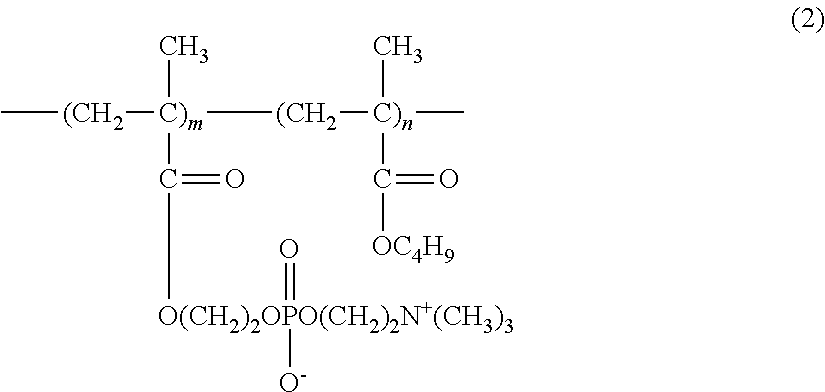Ophthalmic solution
a technology of ophthalmic solution and solution, which is applied in the field of ophthalmic solution, can solve the problems that no effective ophthalmic solution has ever been obtained, and achieve the effects of improving corneal safety, safe use, and improving corneal safety
- Summary
- Abstract
- Description
- Claims
- Application Information
AI Technical Summary
Benefits of technology
Problems solved by technology
Method used
Image
Examples
example 1-1
[0095]To 80 g of purified water, (A) 0.1 g of hydroxypropyl methylcellulose (1) (METOLOSE (registered trademark) 60SH-50; 29.1% methoxy groups, 8.2% hydroxypropoxy groups, methoxy group / hydroxypropoxy group ratio of 3.5, viscosity of 2% aqueous solution at 20° C. of 50 mPa·s), (B) 0.63 g of sodium chloride, 0.1 g of potassium chloride, 0.4 g of boric acid, 0.0076 g of sodium hydroxide, (C) 0.0004 g of Cosmocil CQ (registered trademark) (20% aqueous solution, containing 0.00008 g of hexamethylene biguanide (weight average molecular weight of 2806, from which the number of the repeating units kin formula (1) is 14 in average)), and (D) 2.0 g of medical excipient Lipidure-PMB (registered trademark) (5% aqueous solution, containing 0.1 g of 2-methacryloyloxyethyl phosphorylcholine / butyl methacrylate copolymer (80:20)) were added one after another, and stirred. Then, purified water was added to make the total volume to 100 mL. Then, the resulting mixture was subjected to filter steriliza...
examples 1-2 to 1-10
[0096]A sterile ophthalmic solution was prepared in the same way as in Example 1-1, except that the components of the kinds and amounts shown in Table 2 were used. The appearance, pH, and the osmotic pressure of the obtained solution are shown in Table 2.
TABLE 2Example 1-1Example 1-2Example 1-3Example 1-4Example 1-5Amount (g)Component AHydroxypropyl0.10.10.1methylcellulose (1)Hydroxypropyl0.20.2methylcellulose (2)Hydroxypropylmethylcellulose (3)Hydroxypropylmethylcellulose (4)Component BSodium chloride0.630.740.630.630.74Potassium chloride0.100.130.100.100.13Component C0.00040.00040.00040.00040.0004(net:(net:(net:(net:(net:0.00008)0.00008)0.00008)0.00008)0.00008)Component D2.02.01.03.01.0(net: 0.1)(net: 0.1)(net: 0.05)(net: 0.15)(net: 0.05)OthersBoric acid0.40.40.4BoraxDisodium edetate0.050.05dihydrateSodiumhydrogenphosphatehydrateSodium dihydrogenphosphate anhydrousSodium hydroxide0.00760.00580.00760.00760.0058Purified waterMake total toMake total toMake total toMake total toMake t...
example 2-1
[0109]To 80 g of purified water heated to 80° C., (A) 0.1 g of hydroxypropyl methylcellulose (1) was introduced in small portions, and vigorously stirred with a magnetic stirrer for 30 minutes to obtain a dispersion. The light transmittance at 500 nm of this dispersion at 80° C. was 53.0%. This dispersion was cooled down to 50° C. to obtain a uniform solution. The light transmittance at 500 nm of this solution at 50° C. was 99.4%. To this solution, (B) 0.63 g of sodium chloride, 0.1 g of potassium chloride, 0.4 g of boric acid, and 0.0076 g of sodium hydroxide, (C) 0.0004 gof Cosmocil CQ (registered trademark) (20% aqueous solution, containing 0.00008 g of hexamethylene biguanide), (D) 2.0 g of medical excipient Lipidure-PMB (registered trademark) (5% aqueous solution, containing 0.1 g of 2-methacryloyloxyethyl phosphorylcholine / butyl methacrylate copolymer (80:20)) were added one after another, and stirred. The resulting solution, while maintained at 50° C., was stirred for 1 hour....
PUM
| Property | Measurement | Unit |
|---|---|---|
| viscosity | aaaaa | aaaaa |
| mass ratio | aaaaa | aaaaa |
| mass ratio | aaaaa | aaaaa |
Abstract
Description
Claims
Application Information
 Login to View More
Login to View More - R&D
- Intellectual Property
- Life Sciences
- Materials
- Tech Scout
- Unparalleled Data Quality
- Higher Quality Content
- 60% Fewer Hallucinations
Browse by: Latest US Patents, China's latest patents, Technical Efficacy Thesaurus, Application Domain, Technology Topic, Popular Technical Reports.
© 2025 PatSnap. All rights reserved.Legal|Privacy policy|Modern Slavery Act Transparency Statement|Sitemap|About US| Contact US: help@patsnap.com



